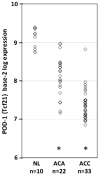POD-1 binding to the E-box sequence inhibits SF-1 and StAR expression in human adrenocortical tumor cells
- PMID: 23313103
- PMCID: PMC5749231
- DOI: 10.1016/j.mce.2012.12.029
POD-1 binding to the E-box sequence inhibits SF-1 and StAR expression in human adrenocortical tumor cells
Abstract
Pod-1/Tcf21 is expressed at epithelial-mesenchymal interaction sites during development of many organs. Different approaches have demonstrated that Pod-1 transcriptionally inhibits Sf-1/NR5A1 during gonadal development. Disruption of Sf-1 can lead to disorders of adrenal development, while increased dosage of SF-1 has been related to increased adrenal cell proliferation and tumorigenesis. In this study, we analyzed whether POD-1 overexpression inhibits the endogenous Sf-1 expression in human and mouse adrenocortical tumor cells. Cells were transiently transfected with luciferase reporter gene under the control of Sf-1 promoter and with an expression vector encoding Pod-1. Pod-1 construct inhibited the transcription of the Sf1/Luc reporter gene in a dose-dependent manner in mouse Y-1 adrenocortical carcinoma (ACC) cells, and inhibited endogenous SF-1 expression in the human H295R and ACC-T36 adrenocortical carcinoma cells. These results were validated by chromatin immunoprecipitation assay with POD-1-transfected H295R cells using primers specific to E-box sequence in SF-1 promoter region, indicating that POD-1 binds to the SF-1 E-box promoter. Moreover, POD-1 over-expression resulted in a decrease in expression of the SF-1 target gene, StAR (Steroidogenic Acute Regulatory Protein). Lastly, while the induced expression of POD-1 did not affect the cell viability of H295R/POD-1 or ACC-T36/POD-1 cells, the most significantly enriched KEGG pathways for genes negatively correlated to POD-1/TCF21 in 33 human ACCs were those associated with cell cycle genes.
Published by Elsevier Ireland Ltd.
Figures







Similar articles
-
POD-1/TCF21 Reduces SHP Expression, Affecting LRH-1 Regulation and Cell Cycle Balance in Adrenocortical and Hepatocarcinoma Tumor Cells.Biomed Res Int. 2015;2015:841784. doi: 10.1155/2015/841784. Epub 2015 Sep 2. Biomed Res Int. 2015. PMID: 26421305 Free PMC article.
-
POD-1/Tcf21 overexpression reduces endogenous SF-1 and StAR expression in rat adrenal cells.Braz J Med Biol Res. 2015 Dec;48(12):1087-94. doi: 10.1590/1414-431X20154748. Epub 2015 Sep 29. Braz J Med Biol Res. 2015. PMID: 26421867 Free PMC article.
-
New evidences on the regulation of SF-1 expression by POD1/TCF21 in adrenocortical tumor cells.Clinics (Sao Paulo). 2017 Jun;72(6):391-394. doi: 10.6061/clinics/2017(06)10. Clinics (Sao Paulo). 2017. PMID: 28658440 Free PMC article.
-
Steroidogenic Factor 1, a Goldilocks Transcription Factor from Adrenocortical Organogenesis to Malignancy.Int J Mol Sci. 2023 Feb 10;24(4):3585. doi: 10.3390/ijms24043585. Int J Mol Sci. 2023. PMID: 36835002 Free PMC article. Review.
-
Adrenocortical development and cancer: focus on SF-1.J Mol Endocrinol. 2010 Jun;44(6):301-7. doi: 10.1677/JME-09-0143. Epub 2010 Mar 3. J Mol Endocrinol. 2010. PMID: 20200142 Review.
Cited by
-
Role of the bHLH transcription factor TCF21 in development and tumorigenesis.Braz J Med Biol Res. 2021 Mar 15;54(5):e10637. doi: 10.1590/1414-431X202010637. eCollection 2021. Braz J Med Biol Res. 2021. PMID: 33729392 Free PMC article. Review.
-
The human adrenal cortex: growth control and disorders.Clinics (Sao Paulo). 2018 Sep 6;73(suppl 1):e473s. doi: 10.6061/clinics/2018/e473s. Clinics (Sao Paulo). 2018. PMID: 30208164 Free PMC article. Review.
-
Upregulation of TCF21 inhibits migration of adrenocortical carcinoma cells.Discov Oncol. 2021 Jul 23;12(1):23. doi: 10.1007/s12672-021-00417-6. Discov Oncol. 2021. PMID: 35201460 Free PMC article.
-
TCF21: a critical transcription factor in health and cancer.J Mol Med (Berl). 2020 Aug;98(8):1055-1068. doi: 10.1007/s00109-020-01934-7. Epub 2020 Jun 15. J Mol Med (Berl). 2020. PMID: 32542449 Review.
-
Sumoylation of TCF21 downregulates the transcriptional activity of estrogen receptor-alpha.Oncotarget. 2016 May 3;7(18):26220-34. doi: 10.18632/oncotarget.8354. Oncotarget. 2016. PMID: 27028856 Free PMC article.
References
-
- Almeida MQ, Soares IC, Ribeiro TC, Fragoso MC, Marins LV, Wakamatsu A, Ressio RA, Nishi MY, Jorge AA, Lerario AM, Alves VA, Mendonça BB, Latronico AC. Steroidogenic factor-1 overexpression and gene amplification are more frequent in adrenocortical tumors from children than from adults. J Clin Endocrinol Metab. 2010;95:1458–1462. - PubMed
-
- Cartharius K, Frech K, Grote K, Klocke B, Haltmeier M, Klingenhoff A, Frisch M, Bayerlein M, Werner T. MatInspector and beyond: promoter analysis based on transcription factor binding sites. Bioinformatics. 2005;21:2933–2942. - PubMed
-
- Cui S, Ross A, Stallings N, Parker KL, Capel B, Quaggin SE. Disrupted gonadogenesis and male-to-female sex reversal in Pod1 knockout mice. Development. 2004;131:4095–4105. - PubMed
Publication types
MeSH terms
Substances
Grants and funding
LinkOut - more resources
Full Text Sources
Other Literature Sources
Research Materials

